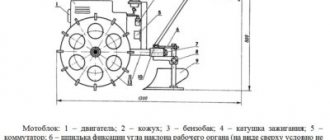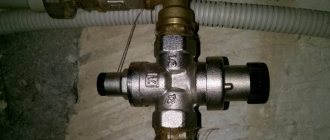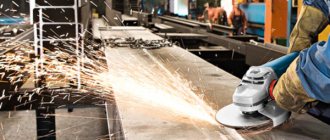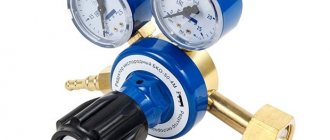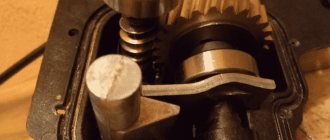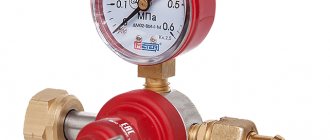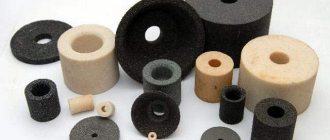Worm
With such a gearbox, it is better not to use attachments; work only with cutters. This type of gearbox is suitable for walk-behind tractors that will work in small areas where the soil has already been previously cultivated.
pros
- High efficiency due to the absence of belt drives.
- This type of gearbox is the most affordable.
- Compactness.
Minuses
- High peak loads cause attachments to become unusable.
- Short service life.
- Questionable reliability.
Reliable worm pairs made of high-quality metal are found in imported cultivators, but they are also expensive. Heavy loads can cause overheating, shearing of gear teeth and damage to the worm. The worm gearbox is suitable for small and pre-prepared areas.
Attachments
By default, the motor cultivator is equipped with cutters and wheels for transportation. This is more than enough for soil cultivation. But if you set more global tasks for your equipment, you need to take care of purchasing attachments. The most popular types of attachments are:
Lugs
Virgin soil plow
Potato digger
Lawn cracker
Hiller
Scarifier
Almost all elements are attached to the trailed part of the cultivator. The exception is cutters and lugs that are installed on the cultivator shaft. The attachment is secured using a bolt and nut, or a pin and cotter pin. The first method is more reliable. But the second one can be used if there are no tools at hand. All these additions will allow you to create a universal device that will take on all the manual work with the soil.
Types of gearboxes
The main purpose of the gearbox is to reduce the rotation speed (reduce the angular velocity) of the low-speed shaft and increase the torque of the output element. The type of mechanical transmission serves as a fundamental principle for distinguishing several types of units:
- cylindrical;
- worm;
- conical;
- planetary;
- globoid;
- wave;
- cylinder-worm;
- cylindrical-conical.
When choosing a product, you need to take into account its technical characteristics (output power, reduction ratio, load torque), advantages and disadvantages.
Homemade design
You can make a gearbox for a walk-behind tractor with your own hands. Before starting work, it is necessary to take into account the engine speed and calculate the maximum load on the mechanism shafts.
Without determining these parameters, the assembled gearbox will not meet the specified power and will quickly fail . Here's what the build process looks like.
- We make the body. To do this, you can borrow a finished product from a motorcycle. If you don’t have a motorcycle at hand, you can weld the body yourself from sheet metal.
- Gears can be removed from the Friendship 4 chainsaw or you can also make them yourself. When making gears yourself, you need to take into account the diameter of the gearbox housing. Therefore, the size of the gears is determined using a caliper.
- To operate the mechanism you will need two gear shafts. These elements can be removed ready-made from the Ural motorcycle and installed in the walk-behind tractor gearbox after minor modifications. At the first shaft, you need to shorten the end cap and drill a hole in the housing. The second shaft is installed on the opposite side of the housing, where you first need to cut a hole of a suitable diameter. The hole must be supplemented with a flange, which is attached to the body using threaded connections. We install a steel washer and a ball bearing inside the flange.
- We connect the shafts to each other using a transmission mechanism.
- We supplement the output end of the shaft with a pulley, which will serve to install a belt drive.
Read also: What is a defect called a weld crater
After these manipulations, you will get an angle-type gearbox.
What is a gearbox
Before you decide to buy a gearbox for a walk-behind tractor (sometimes also called a converter), you need to understand what it is. This is the mechanism that sets the cultivator in motion. Thanks to it, torque is converted into driving force. This occurs through a set of gear-type wheels located in a durable metal housing.
The dimensions of the gearbox depend on the size of the motor cultivator. Sometimes the housing affects how long the walk-behind tractor will last. When choosing a device, you need to pay attention to the quality of the components.
The design of the walk-behind tractor gearbox - the main parts of the mechanism
Having an understanding of how a walk-behind tractor gearbox works, it will be much easier for the owner of an agricultural machine to lubricate and repair the mechanism.
The disassembled gear mechanism of a machine used in agriculture is equipped with the following elements:
- pulley and protective cover;
- ball bearings;
- a bushing located in the area of the input shaft;
- lever for adjustment and timely switching;
- shift axis and fork;
- a gear located in the area of the intermediate shaft;
- shaft block;
- double-row steel chain;
- washer and rubber seals;
- metal input shaft;
- clutch and clutch fork.
The location of each of the listed elements of the walk-behind tractor gearbox will be shown in detail by the diagram.
This design of the gearbox ensures proper operation of the mechanism under almost any conditions. Each detail of its design is important in its own way, so the breakdown or loss of any of them will inevitably lead to a malfunction of the entire mechanism.
What is a motor cultivator?
A motor cultivator is a type of equipment designed to perform various agricultural work. Common work is land work - plowing, harrowing, hilling, etc.
If the motor cultivator is also equipped with various additional equipment, then it becomes in many ways a universal tool, an indispensable assistant to the gardener.
In this regard, a motor cultivator is very similar to a walk-behind tractor. A walk-behind tractor is also used for agricultural work, but it is usually larger in size, more versatile (primarily we are talking about walk-behind tractors with a power take-off shaft), has a larger mass and is significantly more expensive compared to a motor-cultivator, although heavy-duty motor-cultivators are largely similar in function and size and weight with walk-behind tractors.
Types of motor cultivators
All types of motor cultivators are divided into groups by weight:
- Ultralight (up to 15 kg).
- Light (up to 40 kg).
- Medium (45−60 kg).
- Heavy (over 60 kg).
from 1.5 to 10 l. c.high pressure often “bounces”
As part of the small-scale mechanization fleet, there is another device that is close to a motor cultivator in design and purpose. This is a walk-behind tractor. Although walk-behind tractors are sometimes classified as heavy motor-cultivators, they should be distinguished. The walk-behind tractor is not only heavier in weight and has a more powerful drive. The fundamental difference lies in the design.
The walk-behind tractor has a more powerful frame and a developed fastening system, various suspension devices, which can include a plow, a harrow and much more. A walk-behind tractor is essentially a mini-tractor without a driver's seat. It can even be used for transporting goods by mounting a small body or trolley on wheels to it. That is, if a motor-cultivator is structurally intended only for tillage, a walk-behind tractor is a universal draft device.
It is on walk-behind tractors, often used for plowing heavy soils or virgin lands with a plow, that diesel engines are often installed, which operate more steadily than gasoline engines at low speeds.
Motor cultivators can be equipped with an electric drive. The advantage of an electric cultivator is the absence of exhaust, which makes it an indispensable assistant when working in closed greenhouses and winter gardens. When working in small local areas, as they are connected to the power outlet by a cable. At the same time, you need to work with them carefully so as not to damage the electrical cable with the cutter.
Gearbox lubrication
In order to prevent premature wear of gearbox components and reduce power losses as a result of friction, lubrication of bearings and gears is used.
In gearboxes of low power and low meshing speed, lubrication is carried out by splashing or using an oil bath. The worm, wheel (geared or worm) and spray ring are partially immersed in the same oil that is poured into the housing.
To lubricate high-power high-speed equipment, oil is supplied to the engagement zone by a pump from an oil bath. For bearings, lubricant of a liquid or thick consistency is used.
Gearbox selection: worm or cylindrical
Helical and worm gearboxes are the most common. When choosing, you need to be guided by their operating features, functions, and also take into account the area in which they will be used. This will be discussed further.
Worm gear
This device is equipped with a worm-type transmission. The main part of the transmission of the unit is a screw made in the form of a worm. Its distinctive features are its small size and ease of installation. Such gearboxes are used for equipment operating in constant or variable load mode. The direction can be direct or it can change.
Depending on the number of “worms”, the mechanism may have one or several gears. With their number, friction increases and wear resistance decreases. To eliminate these processes, it is necessary to use lubricating oils.
To make it convenient to work with the gearbox, it is connected to an electric motor. Thus, a geared motor is obtained.
Advantages and disadvantages
Buyers give preference in choosing this device due to the following criteria:
- low cost;
- low maintenance costs;
- transmission lock function;
- reliability;
- quiet operation.
Manufacturers guarantee a working life of about a year.
This type of gearbox is equipped with a cooling system. This allows you to maintain the desired temperature of bearings and gears, and the device as a whole. The case is characterized by ribbing, which also leads to cooling.
It is important to remember that leaving the gearbox in the on mode for a long time can lead to its breakdown!
The worm gearbox has the property of blocking the transmission of rotation. This is necessary so that the device cannot work in the opposite direction.
The main advantage of a worm gearbox is its ease of assembly. This makes it possible to save on repairs if they are suddenly needed. After all, the unit is constructed from a small number of components. Due to its compactness, it is easy to install even within a small space.
A significant disadvantage of such equipment is the low percentage of efficiency. As a result of friction, a lot of energy is lost and the degree of heat loss increases. As a result, there is a risk of rapid failure of parts. When compared with cylindrical analogues, worm gearboxes last much less.
Application
Worm gearboxes are divided into types, depending on the conditions under which they will be used. Various models are designed for temperate, dry or tropical climates. To help you make your choice, there is a mark on the body of the device.
Gearboxes are mounted in closed places and in open areas under a canopy. They can be used within 1 km altitude above sea level. It is important that there is not a lot of dust.
A worm gearbox is used to increase the axial rotation torque while simultaneously reducing the rotation frequency. Such converters are widely used in various industrial and agricultural fields.
They are installed in pumps, elevators, escalators, and elevators. It is also used for metalworking machines. Thanks to the gearbox, the motor runs quietly and slowly.
Worm gearboxes should be installed strictly according to the diagram!
Failure to comply with the diagram may result in oil leakage or oversaturation.
As a result, the resource level decreases. The axle should be at the bottom, and the wheels should be on top. If you install a “worm” in the upper part, the output torque decreases. Before starting a new gearbox, it must be run in without load.
Helical gearbox
Helical industrial gearboxes reduce the speed of the motor and increase the torque that is needed for the electric motor of industrial machines operating in intermittent mode. Mounted vertically or at an angle. They play the role of electric drives.
Such mechanisms come with one, two or three gears. They are divided into types depending on the center distance of the shafts.
The main components of a cylindrical converter are shafts, bearings, gears, and lubrication systems.
Advantages and disadvantages
Main advantages of the mechanism:
- high percentage of efficiency;
- no risk of overheating;
- operation in variable load mode;
- the ability to change the direction of rotation;
- versatility;
- kinetic precision;
- low price.
The helical gearbox operates regardless of the mains voltage, so it can solve many industrial problems. The efficiency value can reach 98%. This explains the maximum energy conservation.
Drives with such converters can withstand heavy loads. They transmit high power without thermal loss.
For easy drive installation, helical gearbox manufacturers house them in a flanged box that resembles a gearmotor.
Cylindrical type mechanisms do not have a self-braking function. This achieves reversibility of work, since the output shaft can rotate in the opposite direction.
Gearboxes with two gears can withstand uneven loads.
A large number of advantages does not exclude the presence of disadvantages.
- Using gears, there is a need to increase the number of stages. To do this, you need to increase the dimensions of the mechanism.
- Cylindrical structures are loud.
- The lack of a locking function is an occasional drawback - if you do not need to turn the output shafts when exposed to an external load.
Application
High reliability and extremely rare cases of failures allow this part to be used in industry, agriculture, everyday life, and construction. The vertical gearbox is installed in machines for processing metal and wood, in crushing, lifting devices, grinders, and concrete mixers. They are indispensable in conditions of limited space. The many varieties of such gearboxes can significantly expand the range of applications.
Vertical converters should be mounted so that the axle and gears are parallel. There are two types of installation: mounted, flanged or foot-mounted.
It is necessary to assemble or disassemble a spur gearbox taking into account the design characteristics of a certain type of mechanism. Before the process, you need to read the instructions from the manufacturer.
It is important to remember that before disassembling any type of vertical converter, you need to drain the oil.
Don't forget about preliminary testing of the device.
Cylindrical converters are more in demand due to their high reduction coefficient. But the worm type is a little cheaper and more compact. Each of them has its own strengths and weaknesses that need to be taken into account when purchasing. For selection, assembly or installation, it is recommended to contact professionals.
Spare parts for the Luch walk-behind tractor
There are mounted and repair parts for the Luch walk-behind tractor. Along with the device, special spare parts that are necessary for the user to carry out repairs or other types of work are also sold. The repair and operating instructions for the motor cultivator indicate the following elements that come with the device:
Separately, it is worth noting the mounted spare parts; with their help, the walk-behind tractor performs a huge number of additional works, in addition to agricultural ones.
You can attach the following parts to the walk-behind tractor:
- attachment for wood processing;
- a snow blower with a snow mass discharge of up to 8 m;
- plow;
- ripper;
- trailed trolley, which allows you to transport up to 350 kg of cargo;
- loop and auger drill, with which you can make holes up to 60 cm deep;
- a cultivator that is suitable for loosening the soil;
- extended and special wheels.
Chain
pros
- Low price.
- A simple design that can be easily repaired at home.
Minuses
- The rotation speed of the lower shaft is excessive, it ranges from 140 rpm. Excessive speed leads to the fact that the gearbox crushes the soil too much, making it dense and unsuitable for planting.
- Due to heavy load, the chain stretches over time.
Kinds
Depending on the type of transmission that is used in the gearbox, the devices come in different types. The devices have found their application in various spheres of life.
Chain
The name of the equipment comes from its design - the transmitting element is a chain. There can be several of them in one device. This system of traction transmission through gears and chain, enclosed in a metal housing, is simple and reliable. Most light and medium cultivators are equipped with this type of chain converter because it is cheap and easy to operate. The principle of its operation resembles a bicycle.
The chain gearbox to the walk-behind tractor almost does not dampen the engine speed, so the rotation speed is high - at least 140 rpm. This indicator is very high, so the soil is ground into fluff, becomes very dense and is not enriched with oxygen. The only way out of this situation is to use cutters and attachments of smaller diameter.
With reverse
A gearbox for a cultivator with reverse is often used, since then the equipment has the ability to reverse. Under such conditions, the reverse rotation clutch is mounted with bevel gears located on the main shaft.
But such a system has a drawback - it does not work at high speed. Therefore, you will have to be patient while working.
Belt
The simplest gearboxes on the market are of the belt type. Often, inexpensive converter models are equipped with such a system. A belt is a transmission element that is attached to pulleys. In case of heavy loads, the belt slips or breaks.
Attention!
To prevent slipping, it is necessary to install toothed pulleys and the same belt.
Thanks to belt installations, the harmful effects on the power plant are reduced, since jerks are reduced. They are characterized by simple design and repair.
But such a gearbox also has disadvantages:
- High temperatures cause the belt to stretch. Therefore, adhesion is reduced;
- rapid wear;
- when kinked or twisted, the belt drive breaks;
- if you increase the speed, the belt will begin to slip;
- the location of the pulleys must be in the same plane.
But, despite this list of disadvantages, the belt system is popular.
Gear
Such gearboxes are the most reliable. They are productive and can work for a long time under high load conditions. Thanks to these qualities, a walk-behind tractor with a gear reducer is used in commercial activities or to facilitate work on the farm.
The design looks like this: a set of gears and shafts hidden in a durable housing. This system is standard for heavy walk-behind tractors, especially those equipped with a power take-off shaft
When using a gear reducer, it is important to remember that you must constantly monitor the oil level in the box. Otherwise, you may experience rapid wear of the gears.
The advantages of such a converter include:
- high performance;
- reliability;
- use with PTO;
- correct speed;
- the ability to combine with any type of trailed or mounted equipment.
Among the disadvantages, one can highlight the complex device, so without skills it will not be possible to repair it. In addition, the device is expensive and noisy.
Gear-chain reducer
A popular type of gearbox that is installed on most walk-behind tractors and cultivators. This solution is something between a budget and easy-to-use chain and reliable gear apparatus. Such equipment is often equipped with a gearbox, so you can select the desired speed.
When installing a gear-chain reducer on a walk-behind tractor or cultivator, they can be used in full, with different types of trailed and mounted devices. They can be used to plow virgin soil or cultivate large areas of agricultural land. It is also permissible to carry heavy loads without worrying about the machine breaking down.
The strengths of such a converter include:
- best price-quality ratio;
- high performance;
- reliability;
- ability to use with mounted and trailed equipment;
- quiet work.
Chain reducer
The most popular solution on modern cultivators.
The operating principle of a chain gearbox is as simple as possible; it consists of a chain and two sprockets - lower and upper. The driven sprocket (lower) is located on the working shaft, due to which the mechanism is driven. There are both serviced and non-serviced chain gearboxes on cultivators. On inexpensive and small models designed for work on an area of up to 12-15 acres, as a rule, a chain gearbox with a non-dismountable housing is used, as the reliability of the unit and lubrication is ensured. Enough for the entire service life, which is equivalent to 10 years or more. On larger models and designed to work on land plots of 12 acres or more, as a rule, a chain gearbox with a collapsible housing is used, which over time and with intensive use makes it possible to replace the chain and gearbox lubrication.
The main advantages of a chain gearbox are:
- cheap design,
- low loss of energy transmitted from the engine to the cutters,
- reliability and ease of maintenance,
- narrow body, which simplifies the deepening of the cultivator and during cultivation, allows you to leave a beautiful, even strip of loose soil behind the cultivator,
- possibility of reverse (reverse).
Of the minuses... but somehow you can’t find them
Motoblock device
An important point: almost all machines have the same device and differ only in small details. In order for a person to have a basic understanding of the design, it should consist of a chassis, engine, controls and transmission. It is necessary to consider the diagram of a walk-behind tractor using the example of the MTZ-05 model:
A single-cylinder four-stroke engine (gasoline) can be used in those units that are designed for a small cultivated area and a small garden. It consists of:
- crank mechanism;
- control systems;
- gas distribution mechanism;
- component parts;
- lubrication, ignition, cooling systems;
- starting systems, exhaust gas removal, air supply.
The gearbox changes the gear ratio and transmission of rotation from the gearbox pulley to the wheels. You should consider the diagram of this component in more detail.
Thanks to the gearbox, gears are changed. Often these are 6 (forward) and 2 (backward).
The chassis is very similar to a frame with wheels and basic components of a walk-behind tractor attached to it. The controls themselves consist of a steering column, gear shift rod, gas and clutch control levers, etc.
To make working with a walk-behind tractor in the garden from planting to harvesting comfortable and productive, you should choose among the varieties of walk-behind tractors those that can productively carry out the tasks assigned to them.
Gear
pros
- Can be used with any attachment.
- Optimal rotation speed, multiple gears.
- High reliability and long service life.
Minuses
- Noisy.
- High price.
- Difficult to repair by yourself.
- Some gearboxes have incorrect gear ratios, it is important to study the characteristics.
In general, such gearboxes are quite similar to gear-chain gearboxes.
Maintaining the gearbox is quite easy - you just need to maintain the oil level. If the gearbox is used in normal mode, the oil needs to be changed every 100 hours. With professional use, this time is halved. To check the oil level, you need to use a special dipstick. There are no universal tips here; you need to study the equipment passport. Fill with regular transmission oil.
When purchasing a gearbox, special attention should be paid to whether it is collapsible or non-dismountable. A non-dismountable unit is completely irreparable; if it breaks, the entire assembly must be replaced.
Engine, gearbox and clutch
The engine is the most expensive and critical component of a walk-behind tractor.
Therefore, saving on it means doing repairs every season instead of productive work. The highest quality and most economical engines for these units are produced by GreenField, Subaru, Honda, Forza and BRIGGS & STRATTON. Chinese Lifan power units, produced under license from Honda, have proven themselves well.
Almost all manufacturers of walk-behind tractors today equip their machines with engines from the listed companies. Therefore, there is no point in buying a “pure” Honda, which will cost several times more than the unit on which the Honda engine is installed.
Regarding the number of engine cycles, we can confidently say that four-stroke engines are preferable to two-stroke engines, both in terms of efficiency and reliability.
The walk-behind tractor clutch can have a multi-disc or single-disc design, and is also implemented in the form of a belt drive. The first two types of clutch are more reliable, therefore they are used for installation on heavy machines.
Walk-behind tractor belt clutch
The gearbox of a walk-behind tractor is of great importance for its trouble-free operation, so you should definitely pay attention to it when choosing. Cheap units are equipped with non-removable gearboxes, which in case of breakdown have to be completely replaced
A dismountable, serviceable gearbox is more profitable in this regard, especially if it is made of cast iron rather than aluminum.
Gear reducer
The best design options for gearboxes are gear and gear-chain. The worm gearbox becomes very hot when operating at full load. This leads to the need to stop the walk-behind tractor every 20-30 minutes.
Owner reviews
Novel:
“I have had an excellent Soviet walk-behind tractor since time immemorial, left over from the previous owners of the dacha, when they sold the dacha to us, all the equipment with attachments was, as they say, put to work. I had to dig a little into the stuffing, restore the good old MB-1, and it worked like new! I use it for seasonal work; in winter it just sits in storage.
Advantages: powerful, after major repairs it has never caused any problems, it has been in operation for 8 years.
Disadvantages: new models are now expensive to buy, but this is a pretty decent unit, decent, with a good history, I think it will still serve.”
Motoblocks "Luch": characteristics and operating features
Tilling the soil can only be effective if you use the right tools. One of them is the Luch walk-behind tractor. But they must be used meaningfully and competently, as clearly as possible.
( 2 ratings, average 4 out of 5 )
Gearbox Operation and Maintenance
In order for the gearbox to serve for a long time and properly, it needs to be looked after, undergo daily maintenance, check its technical condition, and conduct an annual inspection. If the mechanism has fulfilled the period of use determined by the operational documentation, then specialists from expert organizations should be involved in the survey. Periodically (after 8000 hours of operation) the oil needs to be changed.
The list of main activities included in gearbox maintenance is quite small:
- wipe with a napkin (rag) or blow with compressed air, freeing the surfaces from dust and dirt;
- measure the oil level;
- make sure that the mechanism is securely fastened to the base;
- check the reliability of the connection of parts and elements;
- check the technical condition of protective elements;
- eliminate identified deficiencies.
Regular maintenance is necessary for safe, long-term operation of the unit.


